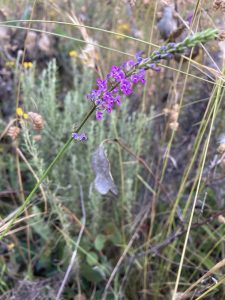Start the New Year with a good deed and help remove St John’s Wort at wildflower patches close to the North Watson project site on Mt Majura at The Fair.
Friends of Mt Majura will host evening weeding sessions in early January to remove St John’s Wort (StJW) from patches which are rich with native plants.
When: from 6pm to 7.30pm on Thursday 6 January and Tuesday to Thursday 11-13 January; the sessions will be cancelled if it rains. We may continue the sessions after 13 January – please watch this space for further announcements.

The Emu-foot, Cullen tenax is a rare species of grassy ecosystems; see CNM sighting here.
Where: nature reserve south of The Fair project site; meet at 6 pm at the volunteer registration point nature park entrance intersection Tay Street and Ian Nicol Street, The Fair, North Watson; please click on this map to view the point; the first sessions will be around the patch outlined blue on the map.
What: hand-weeding StJW.
Bring: Please BYO sun protection, drinking water and garden gloves if you have them; wear long pants and sleeves, and enclosed shoes. We will provide hand sanitiser and disposable gloves.
Inquiries: secretary@majura.org
We have already started to tackle the first large patch which has a high diversity of native flowers, ferns, sedges and grasses and is one of the native rich sites of Mt Majura’s grassy woodland.
Early Nancy, Creamy Candle, Bulbine Lily and Scaly Button plants are prominent in spring. Now, in summer, sweet-smelling Chocolate Lilies, beautiful Fringed Lilies, striking Blue Devils, golden Goodenias, endangered Hoary Sunrays, cute native ferns and sedges, onion orchids, Sticky, Clustered, and Common Everlasting daisies and graceful Wallaby grasses can be seen flowering and fruiting. An exciting addition to the list of native species is the rare Emu-foot, Cullen tenax spotted recently during a hand weeding session; the species is known from only a few sites in Canberra.
Unfortunately, following two La Nina years, the invasive StJW weed has had a very good season, threatening the native understorey of Mt Majura’s grassy woodlands and open forests.
Hand pulling StJW is the best option where it grows among native plants; grabbing the stems close to their base to pull out the roots to prevent re-sprouting. The soft soil after so much rain makes this an easy task.
The photos were taken at a wildflower patch that has been freed of St John’s Wort (W. Pix, December 2021)
St John’s Wort (StJW) was brought to Australia in 1875 as a garden plant. It is a native of Europe, Asia and North Africa, and is now a serious weed in ACT, NSW, Victoria and South Australia as well as in 27 other countries.
Photos of StJW: https://canberra.naturemapr.org/species/6754?p=1







